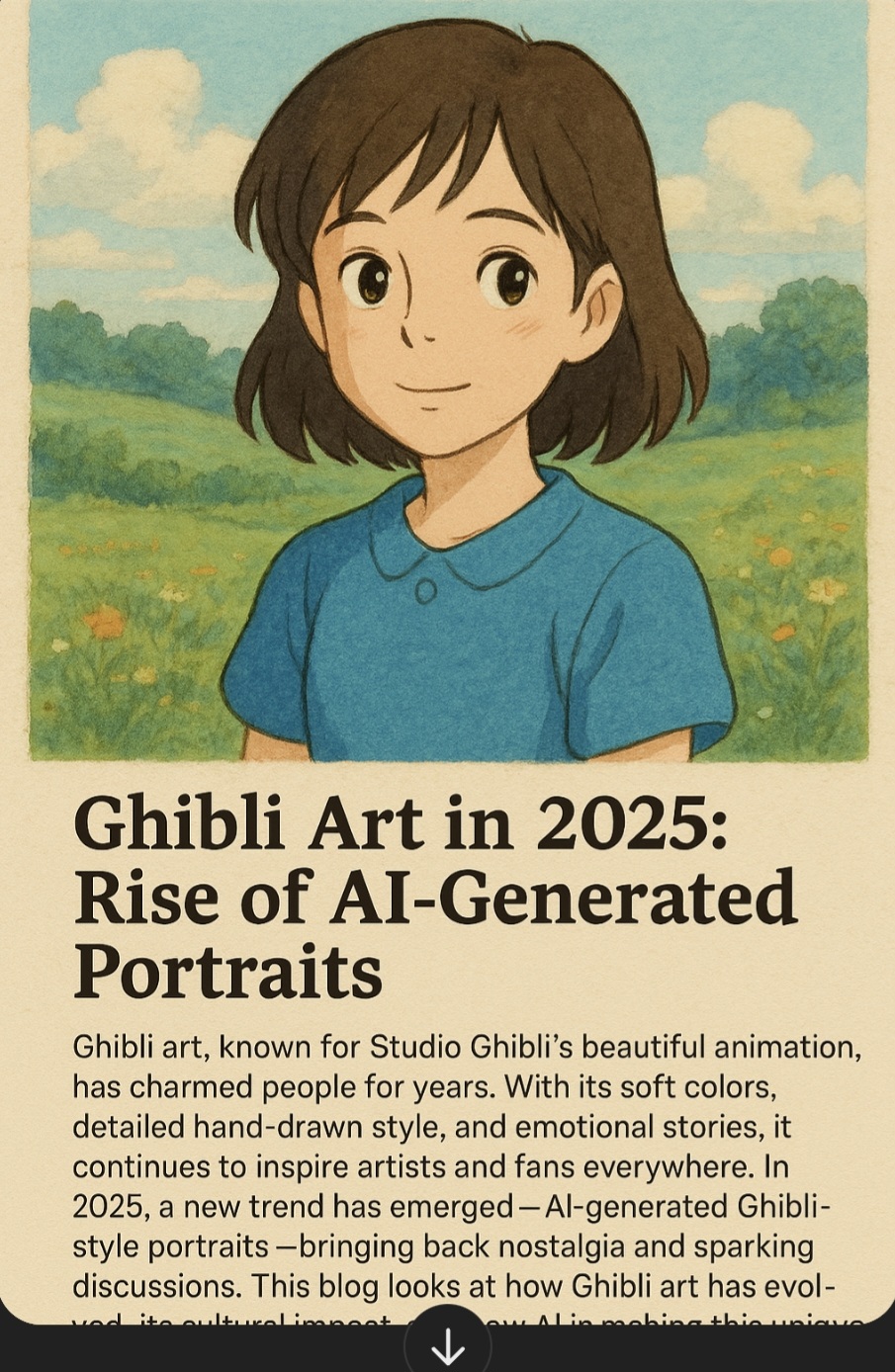Ghibli art, known for Studio Ghibli’s beautiful animation, has charmed people for years. With its soft colors, detailed hand-drawn style, and emotional stories, it continues to inspire artists and fans everywhere. In 2025, a new trend has emerged—AI-generated Ghibli-style portraits—bringing back nostalgia and sparking discussions. This blog looks at how Ghibli art has evolved, its cultural impact, and how AI is making this unique style more accessible.
## **What Defines Ghibli Art?**
Ghibli art is a distinct visual style pioneered by Studio Ghibli, known for its dreamlike worlds and warm, nostalgic atmospheres. Unlike traditional anime, which often features vibrant colors and CGI, Ghibli’s hallmark is its soft color palettes, intricate backgrounds, and deeply expressive characters. Each frame is a handcrafted masterpiece, immersing viewers in enchanting landscapes like the mysterious bathhouse in *Spirited Away* or the idyllic countryside of *My Neighbor Totoro*.
### **Key Features of Ghibli Art:**
– **Hand-drawn animation:** Every scene is painted with meticulous detail.
– **Muted color palettes:** Pastel and earthy tones create a cozy, nostalgic feel.
– **Rich backgrounds:** Lush forests, bustling towns, and serene skies enhance storytelling.
– **Human-nature connection:** Many films highlight ecological themes and personal growth.
## **Why is Ghibli Art Trending in 2025?**
A significant social media trend in early 2025 has put Ghibli-style art back in the spotlight. AI-generated Ghibli portraits, made possible by tools like ChatGPT and KappaNeuro on CivitAI, have taken over platforms like X and Instagram. Celebrities, brands, and influencers have embraced the trend, with companies like Zomato playfully engaging in the phenomenon.
This resurgence is driven by two key factors:
1. **Nostalgia:** Fans of classic Ghibli films are eager to see themselves in a beloved artistic style.
2. **Accessibility:** AI tools allow non-artists to create Ghibli-inspired art with ease.
However, not everyone is thrilled. Some argue that AI-generated art lacks the human touch that defines Ghibli’s soul, leading to ethical debates about artistic integrity and copyright.
## **The Global Journey of Ghibli Art**
While the AI trend is recent, Ghibli’s global appeal has been growing for decades. The studio, founded in 1985 by Hayao Miyazaki, Isao Takahata, and Toshio Suzuki, first gained international recognition in the late 1990s and early 2000s. *Spirited Away* (2001) became a milestone, winning the Academy Award for Best Animated Feature in 2003. Other films like *Princess Mononoke* and *Howl’s Moving Castle* further cemented Ghibli’s reputation worldwide.
### **Major Milestones in Ghibli’s History:**
– **1985:** Studio Ghibli was founded in Japan.
– **1986:** *Castle in the Sky* became the studio’s first official film.
– **2001:** *Spirited Away* won an Oscar, increasing global exposure.
– **2024:** *The Boy and the Heron* won a Golden Globe, continuing the legacy.
## **How to Learn and Create Ghibli Art**
For artists inspired by Ghibli’s charm, there are several ways to learn its techniques. Websites like [gvaat.com](https://gvaat.com/blog/how-to-paint-ghibli-backgrounds/) provide tutorials on painting Ghibli-style backgrounds, focusing on elements like color narratives and brush techniques. Online courses also teach aspiring creators how to capture the studio’s distinctive style using digital tools like Procreate.
### **Key Techniques in Ghibli Art:**
– **Layering colors for depth**
– **Using soft brush strokes for organic textures**
– **Balancing light and shadow to create atmosphere**
## **AI’s Role in Ghibli Art: Innovation or Imitation?**
AI has revolutionized how people interact with art, making styles like Ghibli’s more accessible. Tools like KappaNeuro on [CivitAI](https://civitai.com/models/106712) generate AI-assisted landscapes and characters, allowing users to create stunning Ghibli-style scenes.
However, ethical concerns persist. Miyazaki himself has famously criticized AI in animation, believing it removes the essence of human creativity. Many artists echo this sentiment, arguing that AI-generated Ghibli art, while visually impressive, lacks the heart and storytelling depth of true hand-drawn works.
## **Ghibli Art vs. Traditional Anime: A Quick Comparison**
| **Aspect** | **Ghibli Art** | **Traditional Anime** |
|———————–|—————————————————-|—————————————————|
| **Color Palette** | Pastel, muted, soft | Vibrant, often bright |
| **Animation Technique** | Hand-drawn, detailed backgrounds | May include CGI, sleeker appearance |
| **Themes** | Nature, coming-of-age, nostalgia | Varied, often action-oriented |
| **AI Accessibility** | High, with tools like ChatGPT and CivitAI models | Emerging, but less focused on specific styles |
## **Conclusion: The Enduring Magic of Ghibli Art**
Despite AI’s growing role, Ghibli art remains timeless due to its handcrafted beauty and emotional depth. The current trend highlights both the possibilities and challenges of AI in the artistic world, raising questions about authenticity and creativity. Whether drawn by hand or generated by AI, one thing remains clear—Ghibli’s enchanting style continues to inspire, proving that its magic will never fade.
Would you like me to refine or expand any section further?


This is the heading
Lorem ipsum dolor sit amet, consectetur adipiscing elit. Ut elit tellus, luctus nec ullamcorper mattis, pulvinar dapibus leo.


